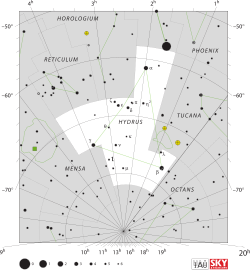Beta Hydri
| Observation data Epoch J2000 Equinox J2000 |
|
|---|---|
| Constellation | Hydrus |
| Right ascension | 00h 25m 45.07036s |
| Declination | –77° 15′ 15.2860″ |
| Apparent magnitude (V) | 2.80 |
| Characteristics | |
| Spectral type | G2 IV |
| U−B color index | +0.11 |
| B−V color index | +0.62 |
| Astrometry | |
| Radial velocity (Rv) | +22.4 km/s |
| Proper motion (μ) |
RA: +2,219.54 mas/yr Dec.: +324.09 mas/yr |
| Parallax (π) | 134.07 ± 0.11mas |
| Distance | 24.33 ± 0.02 ly (7.459 ± 0.006 pc) |
| Absolute magnitude (MV) | 3.45 ± 0.01 |
| Details | |
| Mass | 1.08 ± 0.03 M☉ |
| Radius | 1.809 ± 0.015 R☉ |
| Luminosity | 3.494 ± 0.087 L☉ |
| Surface gravity (log g) | 4.02 ± 0.04 cgs |
| Temperature | 5,872 ± 44 K |
| Metallicity [Fe/H] | −0.10 ± 0.07 dex |
| Rotational velocity (v sin i) | 6.0 km/s |
| Age | 6.40 ± 0.56 Gyr |
| Other designations | |
| Database references | |
| SIMBAD | data |
Beta Hydri (β Hyi, β Hydri) is a star in the southern circumpolar constellation of Hydrus. (Note that Hydrus is not the same as Hydra.) With an apparent visual magnitude of 2.8, this is the brightest star in the constellation. Based upon parallax measurements the distance to this star is about 24.33 light-years (7.46 parsecs).
This star has about 104% of the mass of the Sun and 181% of the Sun's radius, with more than three times the Sun's luminosity. The spectrum of this star matches a stellar classification of G2 IV, with the luminosity class of 'IV' indicating this is a subgiant star. As such, it is a slightly more evolved star than the Sun, with the supply of hydrogen at its core becoming exhausted. It is one of the oldest stars in the solar neighborhood. This star bears some resemblance to what the Sun may look like in the far distant future, making it an object of interest to astronomers.
In 2002 Endl et al. inferred the possible presence of an unseen companion orbiting Beta Hydri as hinted by radial velocity linear trend with a periodicity exceeding 20 years. A substellar object with minimum mass of 4 Jupiter masses and orbital separation of roughly 8 AU could explain the observed trend. If confirmed, it would be a true Jupiter-analogue, though 4 times more massive. So far no planetary/substellar object has been certainly detected.
These results were not confirmed in CES and HARPS measurements published on the arXiv in 2012. Instead the long-term radial velocity variations may be caused by the star's magnetic cycle.
...
Wikipedia

